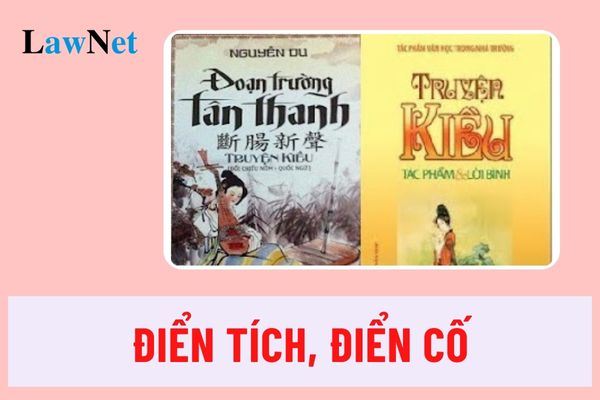What is classic reference? What are characteristics and effects of classic references according to Literature curriculum in Vietnam?
What is classic reference? What are characteristics and effects of classic references according to Literature curriculum in Vietnam?
Classic references are literary elements rich in classic colors, cited from stories, historical events, literature, or famous figures from the past.
- Classic references are tales from ancient books, concisely quoted in the texts of later authors.
- Classic references are also events or phrases in ancient books, quoted in the texts of later authors.
- These tales, scriptures, words, poems... once they have become classic references, are considered models, rich in meaning, so authors often use them to enhance the subtlety, erudition, and evoke rich associations for the readers.
The history of classic references is long and closely linked with the culture and literature of ancient times. Therefore, to understand the meaning of classic references in a work, readers need to study annotations or consult related materials.
Note: Classic references are two closely related concepts, the distinction is only relative.
Characteristics of Classic references:
Origin: Derived from valuable literary, historical, folk works.
Conciseness: Convey profound, subtle, and concise meanings.
Polysemy: Can be understood in different ways depending on the context.
Imagery: Creates vivid, evocative images and associations.
Tradition: Part of the nation's cultural heritage.
Effects of Classic references:
- Enrich the language: Create diversity and richness in expression.
- Enhance imagery and evocativeness: Help readers vividly imagine the described objects or phenomena.
- Increase expressiveness: Clearly convey the writer's feelings and emotions.
- Enhance the aesthetic value of the text: Make the text more erudite and elegant.
- Create a link between the past and present: Help readers gain a deeper understanding of national culture and history.
Example Exercise: Read the footnotes in the text "The Tale of Kieu" and identify instances of classic references. If the textbook does not explain, do you understand the meaning of sentences using those allusions? Why?
- Instances of using literary and classical allusions are:
+ Before My Nuong threw herself into the Hoang Giang River: Ngoc My Nuong, Co Ngu mi
+ When Phan Lang talks and advises My Nuong to return to the world: Tao nga, Horse Tiger roars in the north wind, Vietnamese bird perched on the southern branch.
- Without the textbook, we would not understand the meaning of sentences using classic references because these are ancient folk stories.
Note: the above content is for reference purposes only.

What is classic reference? What are characteristics and effects of classic references according to Literature curriculum in Vietnam? (Image from the Internet)
What are contents of Vietnamese knowledge included in grade 9 Literature program?
Vietnamese knowledge included in grade 9 Literature program is detailed in Subsection 2, Section 5, General Education Program for Literature issued in conjunction with Circular 32/2018/TT-BGDDT:
- Differences in meaning of certain Sino-Vietnamese elements that are easily confused (e.g., dong in dong dao, dong am, dong minh; minh in thanh minh, minh oan, u minh)
- Literary and classical allusions (e.g., Niu Lang - Chuc Nu, Tai ong that ma): characteristics and effects
- Meaning and usage of abbreviations for important international organizations (e.g., UN, UNESCO, UNICEF, WHO, WB, IMF, ASEAN, WTO, ...)
- Transforming and expanding sentence structures (changing the order of sentence components, adding subordinate components, ...): characteristics and effects
- Choosing single sentences - compound sentences, types of compound sentences, conjunctions to connect clauses in compound sentences
- Shortened sentences and special sentences: characteristics and functions
- Literary techniques of puns, repetitive sounds, and repetitive rhymes: characteristics and effects
- Differences between direct quotes and indirect quotes; punctuation usage in direct and indirect quotes
- Text types and genres
+ Narrative texts: stories, imitating a read story; stories converting content from a comic strip
+ Expressive texts: eight-syllable poems; paragraph expressing thoughts about an eight-syllable poem
+ Expository essays: role of thesis statements, arguments, and evidence in expressing the content of the expository text; essays presenting issues and solutions; essay analyzing a literary work
+ Informational texts: presenting ideas and information; effectiveness of non-language means in informational texts; texts explaining social phenomena; texts explaining a famous scenic spot or historical monument; advertisements, leaflets
- Notes on referencing and citing materials to avoid plagiarism
- Language development: new words and new meanings
- Basic understanding of Vietnamese script: Nom script and Quoc Ngu script
- Non-verbal communication means: images, figures, charts, ...
What are literary materials for the grade 9 Literature in Vietnam?
Based on Subsection 2, Section 5, General Education Program for Literature issued in conjunction with Circular 32/2018/TT-BGDDT, the literary materials for the grade 9 Literature in Vietnam includes:
(1) Literary texts
- Legendary tales, detective stories
- Poetry in traditional Vietnamese prosody, Nom poetry, eight-syllable poems
- Tragedies
(2) Expository texts
- Social expositions
- Literary expositions
(3) Informational texts
- Texts introducing a scenic spot or historical monument
- Interview articles

